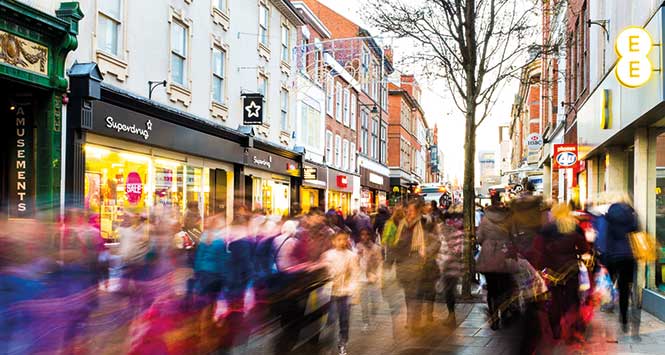Fresh indicators place Scotland near the top of the ‘room for retail growth’ charts. Yet the continuing issue of business rates has been identified as a key stumbling block on the road to actually achieving that growth, particularly for larger businesses.
by Simon Walton
Scotland has been identified as one of just four UK regions which has potential to sustain more retail outlets. That’s according to a survey of the UK’s top 100 retailers carried out by global retail research agency Conlumino on behalf of law firm TLT. Although aimed squarely at the high street end of retail, the optimistic report contrasts starkly with recent data from the Scottish Retail Consortium (SRC) that shows that there are 1,700 fewer shops and 10,000 fewer retail jobs in Scotland than there were just seven years ago.
Local retailing has not been immune to the downturn, with the number of outlets continuing to fall. Despite that fact, the recently published Scottish Grocers’ Federation (SGF) Scottish Local Shop Report shows that Scotland still leads the UK in terms of convenience retail locations per head of population.
Converting potential into reality
The TLT report puts Scotland alongside the South West of England, the West Midlands and London as the areas with the greatest retail growth potential. However, grounds for optimism are tempered when examining how the industry might go about converting that potential into real growth. For many retailers, one of the issues most likely to hinder that conversion is business rates. Although often thought of principally as a problem for larger retailer chains who bear the burden of business rates most heavily, the knock-on effects of reduced high street activity affects convenience retailers too, particularly city centre outlets.
The tax revenue the Scottish Government generates each year from the large firms business rates supplement has soared from £14.4m to £124.8m inside a decade, as figures contained in answers to parliamentary questions have revealed.
“Business rates in general and the large firms’ rates supplement in particular have been ratcheted up year after year with little regard to trading or economic conditions,” argued Ewan MacDonald-Russell, Head of Policy at the SRC. “As these taxes have gone up we’ve seen retail jobs lost and shops closed. These increases in the Large Business Supplement have made it clear to businesses looking to invest in Scotland that they will face higher costs here than elsewhere in the UK. This short-term approach of raising taxes today will lead to lower tax revenue in the future as businesses go elsewhere either online or outside Scotland.”
The continuing hike in business rates clearly hits smaller retailers hard too. The effect of a near nine-fold increase in larger firm tax levies has not been accompanied by any growth in the convenience sector, as might have been expected. Far from it. The SGF has already called for more small businesses, including convenience store retailers, to be completely taken out of the Business Rates system in Scotland, and welcomed the draft budget.
In its submission to the Barclay Review Group (the body established by the Scottish Government to reform the business rates system), SGF argued that such a move would create a fairer, less complex, more efficient and more cost-effective system. The SGF also recommended that occupier improvements should be excluded from any revaluations to encourage investment and avoid an unfair tax burden being applied to any retailer who had upgraded and refitted their store.
Despite the optimism of the TLT report, SGF Chief Executive Pete Cheema has already highlighted that around 3,000 jobs have been lost in the convenience store sector and store numbers fell by almost 300 in 2015, taking contraction in the sector back to the dismal 2012 levels. “We need to reduce the rates burden on retailers and taking as many of them out of the system as possible is the best way to do this,” he said.
Government plans to give local authorities the power to cut rates have received mixed reviews, thanks to uncertainty about how that would impact on services and charges overall. However, over a third of retailers were hopeful that local authorities would set rates with more sensitivity to local trading conditions.
Level playing field
In September of last year, 13 of Scotland’s leading business representative groups combined to sign a joint letter to the Scottish Government calling for the restoration of a level playing field with England, removing the supplement levied on 29,000 medium-sized and larger commercial premises in Scotland. However, in a contrasting and broadly welcomed move, the Cabinet Secretary for Finance, Derek Mackay, announced in his draft budget for 2017-2018 a cut of 3.7% to the business rate poundage as applied to convenience-sized businesses, and that 100,000 properties would become completely exempt from business rates through an increase in the small business bonus scheme threshold.
Even so, business rates are still perceived as a barrier to investment in new stores. Over half of those surveyed for the TLT report (53%) believe that business rates will have a more negative impact this year than last. Perran Jervis, Partner and Head of Retail & Consumer Goods at TLT, said that this will likely hit investment and, for those store operators who lease their premises, increased costs could be around the corner. “Landlords may also face rent review requests from retailers to minimise the impact of the recent rates revaluation, despite transitional relief,” he said.
Bright spots for retailers?
One opportunity identified by the TLT report surrounds travel hubs. Stores near railway terminals or park and ride locations benefit from high footfall from time-pressed consumers. The ability to support click & collect services, notably in forecourt locations, is also part of the drive towards increased investment.







